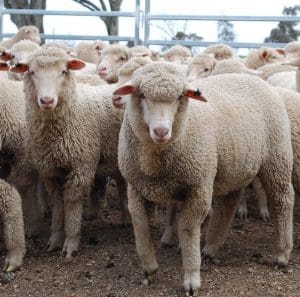
LAMB and wool prices are expected to maintain higher levels throughout 2018-19 due to supply constraints, the latest Australian Bureau of Agricultural Resource Economics and Sciences’ commodities report said today.
However, saleyard sheep or mutton prices are forecast to be constrained — though forecast to lift 3 percent to 430c/kg cwt in 2018-19 — due to increased slaughter.
The ABARES December edition of Agricultural Commodities said Australian lamb saleyard prices are forecast to increase 18pc to average 725c/kg cwt in 2018-19 due to tightening domestic supply and strong export demand.
The national sheep flock is forecast to fall 2pc year-on-year to 68.5 million due to higher sheep turn-off this financial year.
The value of livestock and livestock products is forecast to increase 2pc to $30 billion, supported by higher cattle and sheep turn-off and strong prices for lamb and wool.
ABARES said poor seasonal conditions are expected to reduce the numbers of lambs available for slaughter in autumn 2019, supporting saleyard prices. Strong export demand and high global prices will provide processors with incentives to maintain throughput, the bureau said.
However, ABARES said strong price competition from alternative meats are a downside risk to global lamb prices. The price of lamb relative to other meats has risen significantly, providing cost-conscious consumers with an incentive to substitute away from lamb. Global lamb prices are forecast to remain high, but prices of alternative meats such as beef and pork are expected to fall.
Click here for the ABARES sheep meat report
Wool at risk if trade tensions continue
ABARES is forecasting the wool price benchmark, the AWEX Eastern Market Indicator, to average 1925c/kg clean in 2018-19, up from 1723c/kg in 2017-18.
The 71.7 million sheep expected to be shorn this financial year forecast to produce 385 million kgs of wool, down from 422mkgs in 2017-18, reflecting fewer sheep shorn and lower cuts per head. This expected fall in aggregate wool production is anticipated to support prices for the remainder of 2018-19, despite a reduction in buyer demand resulting in a sharp price decline of 12pc since August 2018.
ABARES said assumed income growth in major markets — such as China, the United States and the European Union — is expected to underpin global demand for fine wool. However, increased uncertainty about future economic growth stemming from trade tensions, especially between the United States and China, could weaken this outlook.
ABARES said dry seasonal conditions in eastern Australia have pushed the average micron lower. This has resulted in an increased but lower-quality supply of superfine wool and has contributed to the decline of premiums and high pass-in rates. Increased offerings of lower-quality and finer micron wool are assumed to continue alongside poor seasonal conditions.
Click here to see AWTA testing by micron
The overall impact of the US–China trade dispute on world textile trade and derived demand for Australian natural fibres remains uncertain, but the dispute could lead to further declines in consumer confidence in China and globally, ABARES said. Semi-processed products, such as yarn and fabrics, were included in the latest round of tariffs announced by the United States, but no trade restrictions have been imposed on finished apparel. ABARES said Chinese consumer confidence and garment sales have been in decline since the escalation of the trade tensions. This could signal weakening textile demand in China, especially for high-value woollen apparel.
Click here for the ABARES natural fibres report
Value of farm production forecast to drop 3pc
Minister for Agriculture David Littleproud said the ABARES Commodities Report shows the gross value of farm production was forecast to drop slightly, but remain above the ten-year average despite drought across Australia.
“The value of our farm production is predicted to drop 3 per cent on last year, to $58 billion in 2018-19.
“This is down only 6pc on our record breaking year in 2016-17,” he said.
“This would still see the value of this year’s production at more than the 10-year average of $56 billion.”
In 2018-19, export earnings for agricultural commodities are forecast to decline by 7 per cent to $46 billion.
The value of crop production is forecast to decline by 7 per cent to $29 billion, driven by substantially lower production of crops, including cotton, wheat, canola and chickpeas.
Farm profitability is likely to be lower in 2018–19 due primarily to lower production and rising input costs, with the most severe impacts in those regions affected by drought.
Mr Littleproud said the report said agricultural exports will be supported by the Trans-Pacific Partnership from 30 December 2018, giving Australian exporters a competitive advantage over countries not part of the agreement.
The full ABARES report is available here.



HAVE YOUR SAY